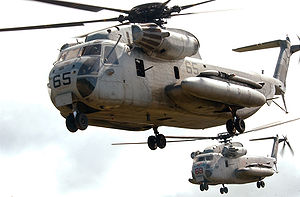 Although the main mission of the United States Marine Corps is accomplished on the ground, US Marines heavily rely on the assistance provided by Marine Corps aviation squadrons. The Marine Corps arsenal includes a variety of both fixed-wing and rotary-wing aircraft capable of fulfilling a variety of roles including attack, close air support, air-to-air combat, and troop transport.
Although the main mission of the United States Marine Corps is accomplished on the ground, US Marines heavily rely on the assistance provided by Marine Corps aviation squadrons. The Marine Corps arsenal includes a variety of both fixed-wing and rotary-wing aircraft capable of fulfilling a variety of roles including attack, close air support, air-to-air combat, and troop transport.
The mainstay of the USMC’s fixed-wing air fleet is its attack aircraft. The AV-8B Harrier II is a single-seat attack jet that is capable of making vertical takeoffs and landings due to its V/STOL technology. After taking off, it can shift the direction of its thrust and proceed into forward flight. The Corps’ main fighter attack jet is the F/A-18 Hornet. Although it requires a full-length airfield or an aircraft carrier to to takeoff, the several different variations of the Hornet allow its squadrons to perform a variety of air-to-air and attack missions.
Marine Corps helicopter pilots are often right in or close to the action on the ground. CH-46E Sea Knights and CH-53D Sea Stallions insert Marine infantrymen onto the battlefield, while AH-1W Super Cobras and UH-1N Hueys provide close air support for those ground personnel.
Many of these helicopters, such as the CH-53 and the UH-1, have been in service for decades. The Marine Corps is currently developing new aircraft to replace these older service models. The new V-22 Osprey, a hybrid helicopter/fixed-wing aircraft, is capable of landing and taking off like a helicopter and then rotating its propellors 90 degrees forward to travel like an airplane. Also being developed are the AH-1Z Viper and the UH-1Y Venom. These modified versions of the Cobra and Huey are equipped with the latest flight and combat technology in order to meet the demands of the modern battlefield.
In recent years, the Marines have added unmanned aerial vehicles (UAVs) to their arsenal. One example is the the RQ-7 Shadow, which is operated by the US Marines, US Army, and several other military forces. The Shadow is used for recon and surveillance, target acquisition and battle damage assessment.
These advances in aviation technology attest to the fact that Marine Corps aviation is constantly evolving to maintain its edge on the modern battlefield. Since the first Marine aviators in 1917 and the Marine squadrons serving throughout the Pacific during World War II, Marine Aviation has earned a powerful reputation and still maintains its proud heritage today.